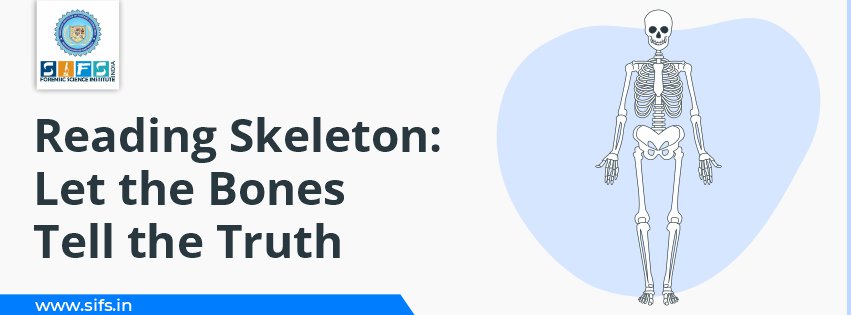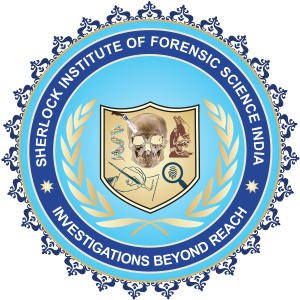- Call Us: +91 7303913002
- Email Us: education@sifs.in
Reading Skeleton: Let the Bones Tell the Truth

BY SIFS India | January 28, 2025
Reading Skeleton: Let the Bones Tell the Truth
“There is a brief but very informative biography of an individual contained within the skeleton if you know how to read it...”
- Clyde Snow, Forensic Anthropologist
Forensic anthropology uses the application and knowledge of physical anthropology to solve crime and problems of medico-legal significance.
They entail figuring out whether the skeletal remains are of human or animal origin, the number of individuals represented, the ancestry, sex, age, and stature of the individuals in question, the pathology, injuries, and anomalies that are present, and the identification of distinctive individual characteristics, the estimation of the time since death, the manner of death, and the cause of death.
How Skeletal Remains can be Used for Identification?
The discovery of skeletal remains prompts numerous questions:
Are they human?
If so, was the person male or female?
What population was he or she from?
How old was the person at death?
How tall was the person?
How long has the person been dead?
What was the most probable cause of death?
And these questions are best answered by trained forensic anthropologists.
Forensic anthropologists are not only able to determine at the site whether skeletal remains are human, but they also employ various methods to determine the following questions of gender, age at death, race, height, etc., of the deceased.
Thus, these questions further lead to the identification of the deceased person.
Role of Forensic Anthropologists in a Criminal Investigation
- Establishment of identity through skeletal remains
- Determination of age, sex, ancestry , stature, and injury
- Useful in studying human variation and evolution
Reading Skeleton
When skeletons are uncovered, forensic anthropologists are brought in to determine their identity. The skeletal discoveries can be interpreted by studying the following key aspects. These are as follows:
Age Estimation: The growth and development stages of the bones and teeth reveal if the remains belong to a child or an adult.
Sex Determination: The best indication of a person's sex comes from their pelvic bone structure.
Stature Estimation: Long bones are used to estimate the stature of an individual.
Ancestry/ Race Determination: Skeletal traces of ancestry can also be found by studying the lifestyle choices, dietary habits, and hobbies that can be shown in the bones and teeth.
Bone Abnormalities: In terms of size, form, or density may be a sign of disease or trauma.
Age Estimation
The pattern of changes in bone growth, development, and fusion, as well as the creation and eruption of teeth, can be used to estimate the age of the skeletons. The criteria used to estimate age at death depend on whether the individual is an infant, sub-adult, adult, or old one. The following are explained below:
Fetal and Infant Remains: It can be estimated based on the length of certain bones and the development and eruption of the teeth.
Sub-Adult Skeleton: Estimated by degenerative changes in the body and by knowing the sequence of this epiphyseal union.
Later Adulthood: Estimated by studying the changes in the pubic symphysis.
Older Adults: Degenerative changes in the spine and joints are used to estimate age.
Other methods include microscopic ageing of bone tissue and age-related changes to the ventral ribs. Moreover, the sutures of the skull also help to estimate the age of an individual as they follow a definite sequence and time of fusion and development.
Sexual Determination in Human Skeleton
Differences between men and women include all the features related to reproduction roles, notably the endocrine ( hormonal) systems and their physical and psychological, behavioral effects. The evaluation of sexual dimorphism in the skeleton is generally based on 2 factors:
1. Size Differences: males are usually larger and muscular
2. Function-related Differences
- Childbirth: unique female pelvic characteristics
- Robusticity: usually more evident in males
The determination of sex is based on the appearance of:
- Skull (cranium and mandible)
- Pelvis (innominate and sacrum)
Table no. 1 Determination of Sex from Skull
|
Characteristics of The Skull |
Male |
Female |
|
Size of the skull and weight |
Large, Massive, and Heavier |
Smaller and Lighter |
|
Shape of orbits |
Squarish and smaller in size |
Rounded and larger in size |
|
Supra-orbital ridges |
More prominent |
Less prominent |
|
Forehead |
Sloping, receding, and slanting |
More vertical, Smoother and bulbous |
|
Mandible |
Square chin and ramus is closer to a right angle to the lower jaw bone. |
Pointed chin and ramus is an obtuse angle to the lower jaw bone |
|
Palate/dental arch |
Larger, rounded, and U-shaped |
Smaller, pointed, and parabolic shape |
|
Nasal aperture |
Higher with sharp margins |
Smaller with round margins |

Figure 1 – Anterior and Lateral view of Male and Female Skull
Table no 2 - Determination of Sex from Pelvis
|
Characteristics of Pelvis |
Male |
Female |
|
Overall appearance |
Thick, heavy, massive with rough muscular markings |
Thick, heavy, massive with rough muscular markings |
|
Sub-pubic angle |
Acute, v-shaped, Smaller |
Obtuse, U-shaped, Broader |
|
Body of Pubis |
Triangular shape |
Quadrangular |
|
Sacrum |
Narrow, longer, and straight |
Broader, shorter, and curved |
|
Pelvic inlet |
Narrow in males |
Larger (To facilitate birth) |
|
Hip Bone |
More vertical |
Less vertical |
|
Pelvic Brim |
Heart-shaped |
Circular or elliptical |
|
Sub-pubic arch |
Inverted V-shaped |
Inverted U-shaped |

Figure 2 – Male and Female Pelvis
Stature Estimation
Estimation of stature is important from a medico-legal perspective. Forensic anthropologists estimate a person’s stature by examining one or more of the long bones. Also, men and women have different proportions of long bones to total height.
An Osteometric board is used to determine the stature and regression equations are employed to estimate the stature of the unknown skeleton remains. Various parameters are used to predict stature as many times long bones are broken or severely traumatized.
Assessing Ancestry from the Skeletal Remains
Determination of skeletal ancestry is difficult as the skeleton does not contain any obvious racial characteristics and also due to intermixture or exogamy there is no pure ethnic group. Anthropologists classify people in general into three basic biological groupings based on skeletal characteristics and geographic location:
- Caucasoid or white Europeans
- Native Americans or Asians /Mongoloids
- Negroids or Black /Africans

Figure 3 – Different Races of Human through Skull
However, there are limitations while dealing with racial characteristics as there is no pure race. But, still, it is used to help narrow down the investigations regarding the identification of skeletal remains.
Skeletal Injury or any Individual Characteristics
The skeleton remains can provide individual traits that can help in determining the identity of their covered individual.
Certain kinds of pathological illnesses that occur during life such as arthritis ( which alters the appearance of joints), many congenital anomalies such as fused vertebrae, bone spurs, malignant tumors, metabolic diseases such as gout and rickets, scurvy , bone infections or fractures, tuberculosis which causes bony deformities can individualize the bone and thus identification can be done.
Also, skeletal injury ( gunshot, stab wounds, animal attacks, etc) gives clues regarding the cause of death.
Recent Advancements in Identification
The advancement in technology and introduction of techniques like X-Rays, CT scans, or other high-powered microscopes provides detailed information about remains without altering them while providing a visual record.
The link between ancient remains and deceased or living descendants can be verified using mitochondrial DNA found in bones and teeth.
Other chemical analyses, such as those involving isotopes, can reveal details about a person's diet and the age of their bones.
Moreover, the technique of superimposing photos of the skull with the photos of missing people is also used to look for consistencies between the bone and fleshed form.
Even in circumstances when there are no photographs, the face can be recreated using the underlying bone structure and accepted norms for the thickness of the facial tissues.
Thus, forensic anthropology is an established scientific area, but it is always changing and improving because of new, cutting-edge global research.
Conclusion
Forensic anthropologists establish the identity of an individual from skeletal remains by determining the age, sex, race, and stature of the individual. Skeletal remains also provide clues to individualize the bone which again aids in identification. Moreover, modern techniques have made it simple to use emerging technologies to identify unidentified skeletal remains.
Note - The figures and images used in this blog are only for educational purposes.
Written by: Habiba Haroon

